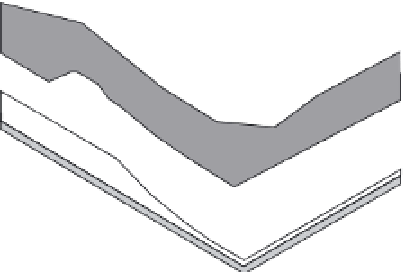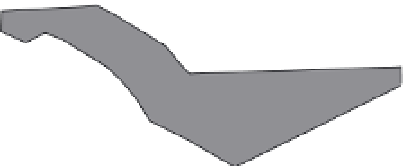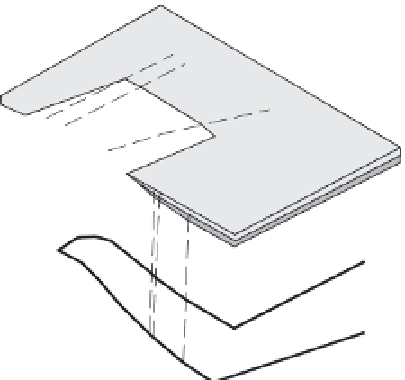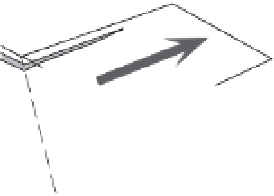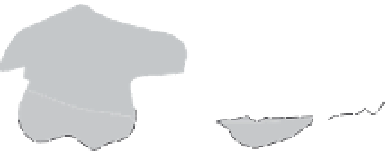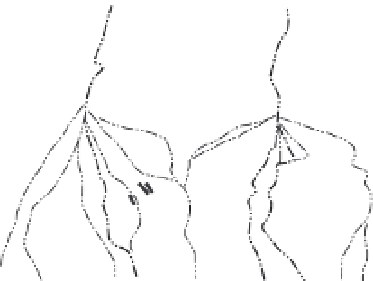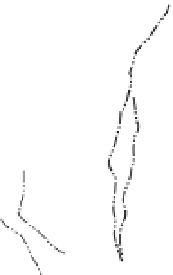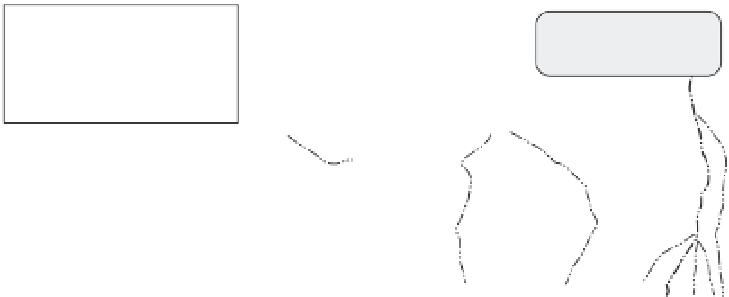Geology Reference
In-Depth Information
old fans
hinterland
Interplay of
Folds and Fans
modern fans
older fold
paleochannels
fan-margin shift
new fold
0
10
20 km
foreland
Fig. 9.23
Growing folds, antecedent rivers, and abandoned paleochannels.
Interactions of an older and younger fold with drainage systems in the southern Tien Shan. The older fold is the Quilitak
fold previously described (Fig. 9.17). North of the newly emergent fold, fan margins have retreated, whereas along the
new fold's crest, abandoned paleochannels record the radial drainages of alluvial fans that pre-date the younger fold.
Only a few of the paleochannels persist as modern antecedent streams. Modified after Hubert-Ferrari
et al.
(2007).
versus the rate of tip propagation and vertical
fold growth, more of the channel flow may some-
day be diverted around the new fold's nose.
In order to determine rates of deformation
and geomorphological modification of growing
folds, dates are needed to define when the fold
propagated into a given position and how
rapidly it grew vertically and laterally. One such
dated structure is Wheeler Ridge anticline near
the southern end of the San Joaquin Valley of
California (Fig. 4.39). Because Wheeler Ridge
encompasses an actively producing oil field,
numerous wells with accompanying electric logs
provide a basis for correlation among the wells,
help to define the stratigraphic boundaries in
the subsurface, and serve to delineate the overall
structure (Medwedeff, 1992). The anticline is
strongly asymmetric, with a relatively steep
(
∼
45
°
) forelimb and much gentler (17
°
) backlimb.
The fault geometry underlying the anticline has
been interpreted as a wedge thrust (Fig. 9.24).
The Wheeler Ridge anticline plunges to the east
and dies in an actively aggrading alluvial plain.
From the fold tip, the differential uplift gradient
is
∼
200 m/km across the easternmost 3 km of the
anticline (Fig. 9.25) (Medwedeff, 1992). The
topographic relief of the fold is considerably less
than the structural uplift, because synfolding
aggradation has raised the surface of the
surrounding depositional basin.
Wheeler Ridge
Anticline
plunging
anticline
growth
strata
piggyback
basin
pre-
growth
strata
wedge
thrust
Fig. 9.24
Block diagram of structure of Wheeler Ridge.
Structural interpretation of a wedge thrust with the
anticline being underlain by a north-vergent thrust fault
and a passive roof thrust. Displacement and uplift
decline eastwards. Modified after Medwedeff (1992).
As the fold propagates, formerly actively
aggrading surfaces adjacent to the fold are
uplifted and incorporated into it. Following
initial uplift, these surfaces accumulate few new
sediments (except some loess) along the crest
of the fold. If the timing of the end of active
alluvial deposition or the age of the soil that
developed on the uplifted surface can be deter-
mined at several points along the fold, these



